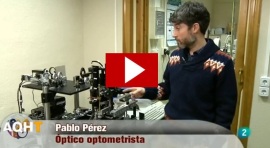Monthly Archives: February 2014
Corneal Biomechanics, 6th video of the VioBio Lab video series
We present the sixth video of a series presenting the custom-technology and applications of our lab. Corneal structure determines corneal shape, which in turn determines optical quality. Several diseases such as keratoconus compromise corneal biomechanical properties. Quantifying corneal biomechanical properties is key in improving diagnosis, increase predictibility and monitor treatment. This video presents several technologies to estimate the corneal biomechanical properties to which VioBio_Lab has largely contributed.
Please, visit VioBio Lab Reseach page to watch all videos of the series, as they are presented
Viobio_Lab Members explain their profession in “Aqui hay trabajo” TVE program
Optometrists Pablo Perez-Merino and Miriam Velasco explain about their work in the lab in the Spanish National TVE Channel TVE1 (Aqui hay trabajo). View a snapshot of their exciting work at the Institute of Optics (CSIC) in this video.
Full RTVE program at: http://www.rtve.es/alacarta/videos/aqui-hay-trabajo/aqui-hay-trabajo-18-02-14/2403664/
Visiting opportunity for the MSIP-supported Career Researchers and Young Researchers in a collaboration with ERC-supported researchers

A new initiative has been launched to boost opportunities for early-career Korean scientists to come to Europe to join the VioBio lab, as one of European Research Council grantees.
The objective of the action is to stimulate co-operation by bringing the best researchers together to exchange ideas and experiences, and to enhance their international profile and knowledge. The initiative will make it easier for early-career Korean top scientists to be part of ERC-funded research teams for 6 to 12 months.
WHO?
- MSIP-supported Career Researchers, funded by the MSIP Career Researchers grants. (Mid-career Researcher Program, Leading Researcher Program)
- MSIP-supported Young Researchers, funded by MSIP Young Researchers grants.
WHAT?
From 6 to 12 months scientific visit to join the VIOBIO lab, a Multidisciplinary, International, Young Team, Worldwide leader in Visual Optics.
Salaries will be covered by the Korean side, according to their MSIP-supported projects’ terms and conditions or the regulations of their organisation in Korea.
ERC projects will reimburse
1. Subsistence costs on a per diem basis, in accordance with the applicable national law and any other rules or regulations applicable on the Susana Marcos’ Host Institution (CSIC).
2. Any other eligible costs incurred during the visiting researchers that are directly related to the ERC-funded project.
HOW?
If you are eligible and interested, please contact as soon as possible Susana Marcos (Susana@io.cfmac.csic.es) to ascertain your common research goals and further details of a prospective visit.
Shortly, ERC will make available a list including Susana Marco’s data as one of the ERC PIs who have expressed their interest to participate in this initiative.
In due course, you will have to submit your application to the Korean MSIP with endorsement of the visit by CSIC and a communication from Susana Marcos.
Once you have been selected by the MSIP, visiting Korean-based researchers may be welcomed into VIOBIO lab for the duration of their visit.
More information:
www.vision.csic.es/default.aspx
@Viobio_Lab
Prof. Susana Marcos, susana@io.cfmac.csic.es
http://ec.europa.eu/research/iscp/pdf/eu_south_korea_implementing_arragement_en.pdf
http://erc.europa.eu/sites/default/files/press_release/files/Highlight_ERC-Korea_agreement.pdf
Longitudinal Corneal (OCT-based) and Total aberrations in Intracorneal Implant treatment of keratoconus, published in AJO
The study explores the longitudinal changes in optical quality in keratoconic eyes implanted with intrastromal ring segments (ICRS).
Corneal aberrations were obtained, for the first time, from OCT. Ocular aberrations were measured with Laser Ray Tracing. ICRS produced a decrease in astigmatism, but on average did not produce a consistent decrease of HOAs. Full study can be found in Perez-Merino et al. “Ocular and Optical Coherence Tomography–Based Corneal Aberrometry in Keratoconic Eyes Treated by Intracorneal Ring Segments”, Am J Ophthalmol 2014;157:116–127.
10 PhD thesis in the last 10 years at @VioBio_Lab
Review all the PhD theses performed in VioBio Lab and defended since February 2004: Sergio Barbero, Patricia Rosales, Elena Garcia de la Cera, Lourdes Llorente, Carlos Dorronsoro, Alberto de Castro, Lucie Sawides, Sergio Ortiz, Pablo de Gracia, and Sabine Kling. Full collection can be downloaded at http://www.vision.csic.es/Publications
Ocular Aberrations, 5th video of the VioBio Lab video series
We present the fifth video of a series presenting the custom-technology and applications of our lab. In this new video you can learn about applications of wavefront sensing technology in the eye, and how the ocular aberrations allow monitoring physiological, surgical or pathological changes in the eye.
Please, visit VioBio Lab Reseach page to watch all videos of the series, as they are presented every two weeks








